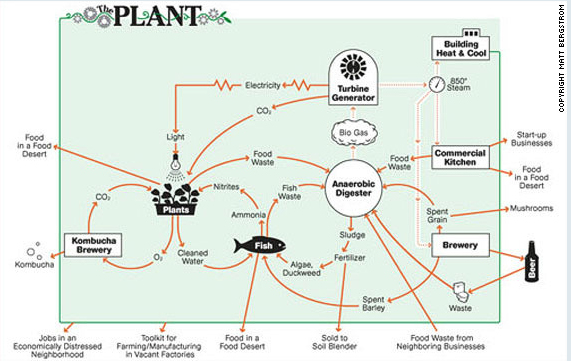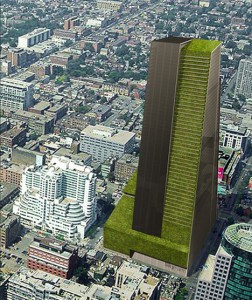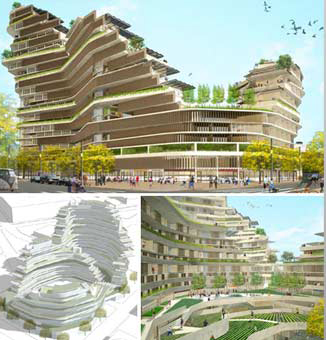Farmville, a New City Life?
This week, we are bringing you the latest urban agriculture related news mixed with lots of good-to-know information and unique projects that are happening across the United States. As efforts to reclaim our food system persist, innovators across the country have been working hard to bring farming back to the urban environment. From low-tech DIY solutions to traditional farming methods, there is a lot to learn and plenty to share. Feel free to share your thoughts and links to your favorite urban agriculture resources, and don’t forget to tell us about the urban farming projects in your town! Mike Lieberman
The vertical farming system allows leafy green vegetables to be grown all year round in urban environments in much smaller spaces, using much smaller amounts of energy and water while generating higher yields.
According to the VertiCrop site, using the system requires just 8 per cent of normal water consumption used to irrigate crops, can work in any climate, can grow more than 50 varieties of leafy green vegetables, and offers yields about 20 times higher than normal production of field crops. Valcent’s vertical farming system was named in 2009 by Time magazine as one of the top 50 innovations of the year.
Urban farming has been around for quite some time now in New York City, all the way back to New Amsterdam times… The idea of having food grown in an urban community might seem strange today, without knowing exactly how it works or why it serves such an important purpose.
For starters food production in America is constantly increasing to support the fast growing population. Our main source of food relies on fertilizer, machinery, transportation, packaging and conditioning- all based on fossil fuels. With an increasing population and over 50% of us living in cities, we need to establish another source of food production.
We believe that urban agriculture serves a vital role in improving urban communities by increasing access to fresh vegetables, improving community interaction and decreasing the footprint of the food system.
CNN says: “An old meatpacking plant on Chicago’s South Side is being transformed into an eco farm, which its founders says will produce food sustainably, while creating zero waste. American entrepreneur John Edel is the founder of “The Plant,” a vertical-farm initiative that he hopes will show people the ease of adapting to green food production in urban living environments.
A vertical farm is an urban agriculture concept whereby food is grown in and on top of buildings in city areas. In order for this process to work, urban farmers use a variety of techniques, including hydroponics — cultivating plants in water — and aquaponics, which uses by-products from fish farming to assist hydroponic growth.
With the world’s population surpassing seven billion people and the rapid pace of urbanization, finding space to grow food is becoming an increasing challenge — one that Edel and his team of volunteers at The Plant are rising to.”
In 2010 Edel began repurposing the meatpacking plant and two years on it has opened its doors to both the public, and business opportunities. Edel says of The Plant’s ethos: “It started out minimal (waste) because that’s how I’ve always operated … Using as little resource as possible to do things. At a certain point I realized if we built an anaerobic digester, we could get our waste down to zero.”
The Plant’s anaerobic digester uses bacteria to break down organic waste into biogas — comprised of methane and carbon dioxide — and material that can be used as fertilizer. A “combined heat and power system” will convert the methane into energy, which Edel says will take The Plant completely off grid and allow it to produce large quantities of food with zero waste output.

Despite still being under construction The Plant currently has five tenants, including aquaponic farms, a hydroponic farm, bakers, tilapia fish breeders, a mushroom garden and a kombucha tea brewer (a type of tea said to have health benefits). Their products are sold to local restaurants, cafes and markets, as well as used to produce more food within the farm itself. Edel hopes to have the farm fully operational by 2014 and says that the facility will create 125 new local jobs.
A Swedish-American company called Plantagon has conceived of an incredible solution: a massive urban greenhouse contained within a geodesic dome. The vertical farm, which consists of a spiral ramp inside a spherical dome, is currently in the development stages. According to Plantagon, the farm “will dramatically change the way we produce organic and functional food. It allows us to produce ecological [resources] with clean air and water inside urban environments, even major cities, cutting costs and environmental damage by eliminating transportation and deliver directly to consumers. This is due to the efficiency and productivity of the Plantagon® greenhouse which makes it economically possible to finance each greenhouse from its own sales.”
No word on how exactly the Plantagon system works, but the company says that consulting engineering firm Sweco has helped untangle the technical kinks of the project. Plantagon hopes to have its first vertical farm up and running within three years.
Plantagon seems to have traded in its initial geodesic dome design for a sheer tower that both contains and showcases the plants growing inside. This prototype building will be called the International Centre of Excellence for Urban Agriculture, and it will be a place for scientists to test new technologies aimed at improving urban farming.
Inside the massive glass walls, vegetables will be grown in pots and then transitioned to trays positioned around a giant central helix. The plants grow as the trays slowly migrate down the central core and are ready to be harvested once they reach the bottom. Plant residue and manure will be collected along the way and transformed into biogas to run the heating and cooling systems of the greenhouse. Scientists want the vertical farm to not only grow food but also help in developing sustainable solutions for energy, heat, waste, and water issues of daily city life.
Construction on the company’s first enormous vertical greenhouse is expected to take 12 to 16 months.
 Gordon Graff of the University of Waterloo, Ontario, designed the Skyfarm to appeal to green-minded Canadians who want to see cities taking action. His 59-story building is covered in vegetation: a hydroponic farm that would produce about 50 percent of its own needed power with an on-site biogas plant burning farm waste. The other half of the needed energy could come from city waste, according to Graff.
Gordon Graff of the University of Waterloo, Ontario, designed the Skyfarm to appeal to green-minded Canadians who want to see cities taking action. His 59-story building is covered in vegetation: a hydroponic farm that would produce about 50 percent of its own needed power with an on-site biogas plant burning farm waste. The other half of the needed energy could come from city waste, according to Graff.
There is no shortage of vertical farm ideas these days; it’s becoming more apparent with each passing year that crop space is running out and we’ll soon need to figure out a better way to feed ourselves. Many vertical farm ideas look similar and share the same functions, but this one is a bit different: it’s situated in the ocean instead of on land.
Could a sea-based vertical farm have an advantage over a land-based one? It’s very possible. This particular design is from Australian architect Ruwan Fernando. Fernando’s design consists of five stacked U-shaped enclosures, which can be used for a variety of functions: public space, residences, research, food production, energy production and more. The shape of the levels – and the space between each – helps to let in the maximum amount of natural sunlight, reducing the electricity needed to power the structure. Fernando sees several of his sea-based skyscrapers being grouped together to form a networked food production colony.
What makes Fernando’s idea truly unique is the fact that it’s meant to be placed in shallow ocean water. It would be close enough to the shore that a bridge would take workers and visitors from the mainland to the farm easily. But why put it in the water at all? The designer believes that instead of moving inward and taking up more green space – as has been the trend for a very long time – we should be focusing our movement outward, toward the “uninhabitable” 70 percent of the planet that is covered in water.
 Being located in the water will make it easier for these vertical farms to harvest energy from wind and waves. Because there are no other structures in the water to block the sun, solar energy would also be plentiful. The surrounding seawater would be utilized both for fresh water (after desalination) and to provide minerals to nourish the plants. Of course, current technology is miles away from making a vertical farm like this a possibility, but looking to the ocean as a viable farm site is a step forward in vertical farm design.
Being located in the water will make it easier for these vertical farms to harvest energy from wind and waves. Because there are no other structures in the water to block the sun, solar energy would also be plentiful. The surrounding seawater would be utilized both for fresh water (after desalination) and to provide minerals to nourish the plants. Of course, current technology is miles away from making a vertical farm like this a possibility, but looking to the ocean as a viable farm site is a step forward in vertical farm design.
Concept design (Standard): Co-Op Canyon inspired by Anasazi cliff-side villages. The community is intended to house 1,000 residents and be completely self-sustainable, producing enough food, power and water for the entire village.
When people think of urban areas, they usually think of lots of concrete, tall buildings and not much green space. In fact we will have such diversity of green buildings and new exiting technologies, that life will be kind of amazing, for sure interesting and far from the old ways.. By allocating space for urban agriculture, individuals get reconnected with their food source and nature while still enjoying the city life. It can help to serve as an escape from the everyday craziness that has become our lives.
GreenDustries loves these new methods of combining urban life and nature! Saving energy is the only solution for a healthy future for our children, all mankind and ourselves. It seems to us like a new and exciting way of life is up ahead. Combining glass, concrete and of greenery will bring balance to our cities. We look forward for that time to come quickly.
Visitors: 26999




No comments yet.